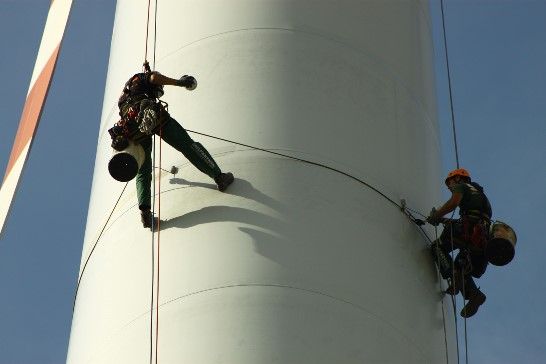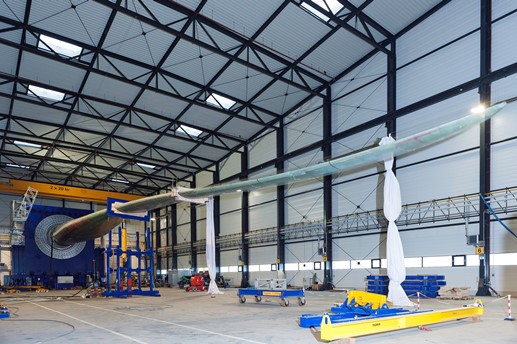Researchers with the Fraunhofer Institute for Wind Energy and Energy System Technology (IWES) (Dresden, Germany) are working on a project with offshore wind farm operator WindMW Service GmbH (Bremerhaven, Germany) and other partners to explore alternative inspection methods for offshore assets, which could be used to spot problems such as coating delaminations that could lead to corrosion.
“What we need are flexible methods that allow wind-turbine rotor blades to be inspected in situ in a minimum of time and without long preparation, and yet still deliver results that are as reliable and conclusive as those obtained when inspections are carried out by industrial climbers,” says Holger Huhn, director of research and development at WindMW.
In two parallel approaches,1 their goal is to reduce wind turbine downtime and perform maintenance with fewer personnel. One approach comprises unmanned aerial vehicles (UAVs), or drones, in combination with mobile thermography technology. Meanwhile, the other strategy involves the deployment of an acoustic emissions monitoring system.
Limits of Traditional Inspections
According to project partners, offshore wind farms are especially prone to maintenance issues because extreme conditions at sea can cause materials to degrade much faster than on land. Specific stress factors cited include greater exposure to ultraviolet radiation, high wind speeds, and salt-laden air. Even minor surface damage can generate turbulence, they say, resulting in lower efficiency. Historically, industrial climbers have been used to regularly inspect the rotor blades on turbines. Climbers typically check for signs of coating delamination and other forms of damage by tapping on the structure and examining its visual appearance.

The limited accessibility of these wind farms and the unpredictability of maritime weather conditions, however, makes it difficult for operators to plan for and budget the deployment of these maintenance teams. For example, the project partners explain that one common problem is that operators will call out a maintenance crew to conduct an inspection—but then send them home without the job being completed because the window of acceptable weather is too short to permit high-altitude work.
As a result, they say, industry operators are searching for alternative structural monitoring methods that are equally as reliable as regular inspections by industrial climbers, but without the human risk.
Drones with Mobile Thermography
In the mobile thermography solution, the researchers say their goal is to detect subsurface defects in composite materials by attaching thermal imaging cameras to drones. These defects can include delamination, inclusions, faulty bonding in the loadbearing web-flange joints, and shrinkage cavities. Possible causes in a maritime environment often include rain erosion, the partners explain.
This portion of the project is led by engineering consultant Deutsche WindGuard Engineering GmbH (Varel, Germany) and the Bremen Institute for Metrology, Automation and Quality Science (BIMAQ) (Bremen, Germany), which explain that structural defects in rotor blades cause friction. In turn, this generates heat—which can be detected in the material by means of thermal imaging.

In their work, a passive thermography technique is used in which heat flow measurements are based on the intrinsic heat of the object under test, or on variations in temperature relative to the usual daily cycle. The partners say they have successfully applied this type of thermal surveying to visualize heat flow in operating onshore wind farms for several years. The new challenge, however, is to adapt the technique to the unique requirements of offshore installations.
“Our aim is to combine different test methods so that damage is detected sooner, thus avoiding the need for emergency shutdowns,” says Nicholas Balaresque, CEO at Deutsche WindGuard Engineering. “It also allows operators to carry out targeted rotor blade inspections.”
The partners say they have already successfully completed some initial laboratory tests of the thermography system. As part of further validation tests, evaluation algorithms are being developed at the University of Bremen’s (Bremen, Germany) wind energy research facility. To complement this work, the offshore operator involved in the project is designing various application scenarios. As the technical development continues in 2018, the partners say they are also focused on selecting the most suitable camera system and drones to carry out this type of work.
Acoustic Emissions Measuring
Meanwhile, the second approach involves a nondestructive acoustic emission measuring system integrated into the rotor blade. This system serves as an early warning system by detecting internal damage, such as at the foot of the rotor blade.

Developed by Fraunhofer IWES, the system involves attaching acoustic emission and piezoelectric sensors to the inner surface of the blades at structurally relevant areas—particularly at known weak points. The measurement computing device that collects and analyzes the sensor data is integrated in the rotor hub.
“The sensors work in much the same way as microphones,” explains Stefan Krause, project manager at Fraunhofer IWES. “If the tensile forces in a specific area of the rotor blade suddenly change, the structure releases energy in the form of heat and surface waves that can be measured by the sensors. The sound waves captured by each sensor have different signal delays. By analyzing their arrival times, it is possible to pinpoint the source of the damage.”
The team says it has already found convincing results from the system during lab tests conducted at the institute’s rotor-blade testbed facility. In static rotor blade and fatigue tests, the researchers say they were able to identify numerous types of damage including adhesive and inter-fiber fractures, damage to web-flange joints, cracks in the trailing edge of rotor blades, and faulty bonding in the blade root area.
The next step involves testing the system under real-life conditions, they say, rather than just in the laboratory. To do this, tests are planned in the spring of 2018 at the Meerwind Süd and Meerwind Ost offshore wind parks off the coast of Helgoland in northern Germany.
Time Saver
While steps remain in the process to prove its commercial viability, project partners are optimistic that the method can ultimately lower inspection costs and reduce asset downtime. For instance, Krause explains that an industrial climber typically needs an entire day to inspect a rotor.
“Using drones, the same work could be done within one hour,” he says. “And a targeted inspection based on the results of acoustic emission measurements would require even less time. These new technologies, particularly in conjunction with drones, complement traditional inspection activities by offering an efficient, safe means of inspecting rotor blades.”
Source: Fraunhover IWES, https://www.fraunhofer.de/en.html. Contact Holger Huhn, WindMW—email: holger.huhn@windmw.de or Stefan Krause, Fraunhofer IWES—email: stefan.krause@iwes.fraunhofer.de.
Reference
1 “Inspecting Rotor Blades with Thermography and Acoustic Monitoring,” Fraunhofer-Gesellschaft Press Releases, Dec. 1, 2017, https://www.fraunhofer.de/en/press/research-news/2017/december/inspecting-rotor-blades-with-thermography-and-acoustic-monitoring.html (Jan. 15, 2018).